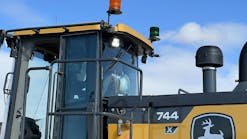To quote Yogi Berra, “You can observe a lot by just watching.” It’s the same when you look at employees, foremen, supervisors, and craft workers busy doing their jobs on the shop floor or around the job site.
When it comes to safety, you should be looking for dangerous or risky activities that could potentially hurt or kill someone.
“Many workers are injured or killed on job sites every day,” Jason Ruggles told attendees of AEMP’s Management Symposium last fall. Ruggles, now equipment manager for J.M. Marschuetz, urged fleet professionals to create an Activity Hazard Analysis (AHA), sometimes called a Job Hazards Analysis (JHA). Such a document focuses on a particular task and identifies hazards before they occur. (Watch Ruggles' full presentation below.)
Ruggles describes a hazard as “simply the potential to harm.”
Identifying these hazards and eliminating, mitigating, or controlling them as early in the process as possible helps prevent injuries, he says. In addition to the obvious benefit to safety, AHAs can add value to your business, your job, and your life, he says.
“An AHA also can be used to establish proper job procedures to help individuals understand the hidden risks of their jobs. You can ‘call out’ the analysis for accident investigations, and from a management perspective, it’s a good way, among others, to reduce worker’s comp claims,” Ruggles says.
Of course, not every job is appropriate for an AHA, but those that are include any work that is new to your operation and job site processes; jobs that have had their processes changed or altered; and jobs that are so complex they require written instructions.
“You also should have a written plan for complex jobs to mitigate the risk,” Ruggles says.
Once completed, the most effective way to implement an AHA is by “engineering controls that physically change the machine or process and remove
the employee from the situation completely,” Ruggles says.
If that cannot be done, administrative controls can often be put in place to cut down the risks, but that requires a closer look at how the task or job is performed.
Another step in the corrective process is to evaluate the risk and adopt the appropriate control and—perhaps the most important step in developing an AHA—tell everyone involved about the change.
Otherwise, Ruggles says, “Change in itself can be hazardous [because it] creates uncertainty, and with uncertainty comes injury.”




